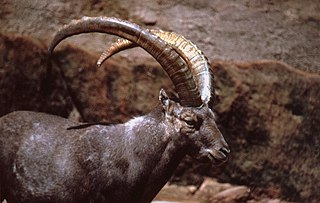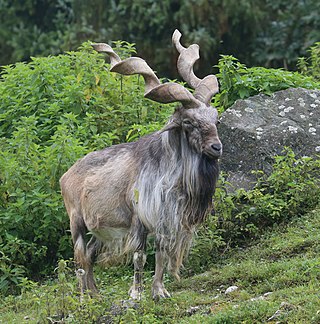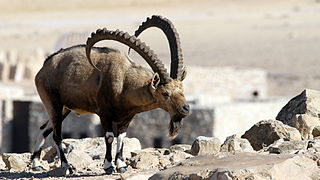
An ibex is any of several species of wild goat , distinguished by the male's large recurved horns, which are transversely ridged in front. Ibex are found in Eurasia, North Africa and East Africa. The name ibex comes from Latin, borrowed from Iberian or Aquitanian, akin to Old Spanish bezerro "bull", modern Spanish becerro "yearling". Ranging in height from 70 to 110 centimetres (27–43 in) and weighing 90 to 120 kilograms (200–270 lb), ibex can live up to 20 years. Three closely related varieties of goats found in the wild are not usually called ibex: the markhor, western tur, and eastern tur.

The Alpine ibex, which is also known as the steinbock, is a species of goat that lives in the Alps of Europe. It is one of ten species in the genus Capra and its closest living relative is the Iberian ibex. The Alpine ibex is a sexually dimorphic species; males are larger and carry longer horns than females. Its coat is brownish-grey. Alpine ibexes tend to live in steep, rough terrain and open alpine meadows. They can be found at elevations as high as 3,300 m (10,800 ft) and their sharp hooves allow them to scale their mountainous habitat.

Capra is a genus of mammals, the goats, comprising ten species, including the markhor and several species known as ibexes. The domestic goat is a domesticated species derived from the wild goat. Evidence of goat domestication dates back more than 8,500 years.

The markhor is a large wild Capra (goat) species native to South Asia and Central Asia, mainly within Pakistan, India, the Karakoram range, parts of Afghanistan, and the Himalayas. It is listed on the IUCN Red List as Near Threatened since 2015.

The argali, also known as the mountain sheep, is a wild sheep that roams the highlands of western East Asia, the Himalayas, Tibet, and the Altai Mountains.

The Iberian ibex, also known as the Spanish ibex, Spanish wild goat and Iberian wild goat, is a species of ibex endemic to the Iberian Peninsula. Four subspecies have been described; two are now extinct. The Portuguese ibex became extinct in 1892, and the Pyrenean ibex became extinct in 2000. A project to clone the Pyrenean ibex resulted in one clone being born alive in July 2003, making it the first taxon to become "un-extinct", although the clone died several minutes after birth due to physical defects in its lungs.

The West Caucasian tur is a mountain-dwelling goat-antelope native to the western half of the Caucasus Mountains range, in Georgia and European Russia. It is listed as Endangered on the IUCN Red List, as the wild population is estimated to be between 5,000 and 6,000 individuals.

The East Caucasian tur, also known as the Daghestani tur, is a mountain-dwelling caprine living in the eastern half of the Greater Caucasus mountains, in Azerbaijan, Georgia, and European Russia. It inhabits rough mountainous terrain, where it eats mainly grasses and leaves. It is listed as near threatened on the IUCN Red List.

The Nubian ibex is a desert-dwelling goat species found in mountainous areas of northern and northeast Africa, and the Middle East. It was historically considered to be a subspecies of the Alpine ibex, but is now considered a distinct species. The wild population is estimated at 4,500 mature individuals, and it is classified as vulnerable.

The walia ibex is a vulnerable species of ibex. It is sometimes considered an endemic subspecies of the Alpine ibex. If the population were to increase, the surrounding mountain habitat would be sufficient to sustain only 2,000 ibex. The adult walia ibex's only known wild predator is the hyena. However, young ibex are often hunted by a variety of fox and cat species. The ibex are members of the goat family, and the walia ibex is the southernmost of today's ibexes. In the late 1990s, the walia ibex went from endangered to critically endangered due to the declining population. The walia ibex is also known as the Abyssinian ibex. Given the small distribution range of the Walia ibex in its restricted mountain ecosystem, the presence of a large number of domestic goats may pose a serious threat that can directly affect the survival of the population.

The Siberian ibex, also known using regionalized names including Altai ibex,Asian ibex, Central Asian ibex, Gobi ibex, Himalayan ibex, Mongolian ibex or Tian Shan ibex, is a polytypic species of ibex, a wild relative of goats and sheep. It lives in Central Asia, and is, by far, the most widely-distributed species in the genus Capra. In terms of population stability, Siberian ibex are currently ranked as Near Threatened, mostly due to over-hunting, low densities and overall decline; still, reliable data is minimal and difficult to come by, in addition to the animals’ expansive natural range, so accurate observations are still scant. The Siberian ibex has, formerly, been treated as a subspecies of the Eurasian Alpine ibex, and whether or not it is a single species or a complex of distinct units that stand out as genetically-distinct is still not entirely clear. The Siberian ibex is the longest and heaviest member of the genus Capra, though its shoulder height is slightly surpassed by the markhor.

Chitral Gol National Park is one of the National Parks of Pakistan. It is located in Lower Chitral District in Khyber-Pakhtunkhwa province of Pakistan beside the Chitral River, at a distance of two hours drive from Chitral town. The park is also known as Chitral National Park.
Dashkin is a village in Astore, Pakistan. It is 85 km from Gilgit, the capital of Gilgit-Baltistan. It has over 5,000 inhabitants, primarily farmers and herdsmen.

The feral goat is the domestic goat when it has become established in the wild. Feral goats occur in many parts of the world.
The Astor markhor or flare-horned markhor is a subspecies of the markhor, native to Kashmir and northern Pakistan. To the west it reaches the easternmost parts of Afghanistan. The range of the Astor markhor is very scattered. At one time considered an "endangered species", conservation efforts have had some success and the largest subpopulation in Pakistan may now exceed 1000 individuals. As a result, the International Union for Conservation of Nature has rated its status as "near-threatened".

The Bukharan markhor, or Tadjik markhor is an endangered goat-antelope, native to Tajikistan, Turkmenistan and Uzbekistan, possibly also Afghanistan. Today it is found in few scattered populations, for example in Kugitang Nature Reserve in easternmost Turkmenistan. The population of the Bukharan markhor is at around 5,750 animals.
The Kabul markhor is a subspecies of Markhor. This near-threatened goat-antelope is native to Afghanistan and Pakistan.

The Girgentana is an Italian breed of domestic goat indigenous to the province of Agrigento, in the southern part of the Mediterranean island of Sicily. The name of the breed derives from Girgenti, the name of Agrigento in local Sicilian language. There were in the past more than 30,000 head in the hills and coastal zone of the province. Today, however, this breed is in danger of disappearance.
The Sulaiman markhor or straight-horned markhor is a goat endemic to Asia. It is a subspecies of Capra falconeri. Scientists differ regarding whether it is the same subspecies as the Kabul markhor.
Trophy Hunting in Pakistan is a form of hunting for sport in which parts of the hunted wild animals are kept and displayed as trophies. Pakistan harbors a collection of the most uncommon types of wild sheep and goats on the planet. These include the Blue Sheep, Kashmir, Astor, and Suleman Markhors, as well as Punjab, Blandford, and Afghan Urials, alongside the Himalayan and Sindh Ibex.
















